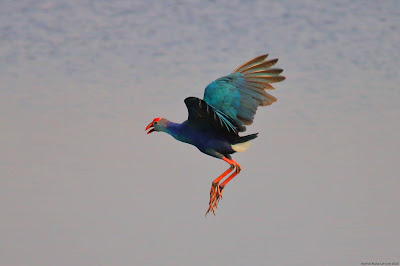Situated on the Gurgaon-Jajjhar road, right adjacent to the Basai Water-treatment plant is a narrow lane seemingly leading to nowhere. On the right-hand side of the lane is a tall wall rather like the Great Wall of China and on the right-hand side is a pile of Debris meant to be processed by the so-called construction wast-treatment plant. One can reach the wetland from the Dwarka-Express way, or one can take the Basai Jajjhar road and then turn right after descending the flyover.
One of the most interesting bird species one can find at the wetland in the Purple Swamphen. These rather garishly coloured birds are rather funny. They chase each other around the wetland and make some of the funniest sounds. They often fly at a low height, but then I have also seen a few flying really high up in the sky! These colourful birds that very long toes and fingers. They are waders, therefore, they need big feet so that they can probe the water-bottom for succulent roots and weeds to eath.
Painted Storks can also be found in large numbers at the Basai Wetland. These really huge birds are a joy to photograph while flying. Painted Storks too are waders and they use their feet while foraging in the shallow water for insects, small fish and other food items.
But then there are quite a few more birds to be in the Basai Wetland and these include, Purple Heron, the common Pond Heron, Bitterns, Pheasant-tailed Jacanas
.
Unfortunately, this wetland is threatened by developmental activities taking place in the area. What was once a thriving fresh-water body teaming with indigenous species of fish has now been taken over by the banned African Catfish. The Wetland that stretched over an area of more than eight square acres now measure much less, barely four or five acres. The Basai Wetland is an important rainwater catchment area and filling it up will result in extreme flooding of the area. What people don't realise is that such wetlands act as important buffers against droughts and dry seasons. Gurgaon now has lost most of its catchment areas, many of which were once protected by bunds constructed by the British Administration during the late 1800s and early 1900s. Most of the old land records that clearly demarcate wetlands, bunds and forest areas have somehow been lost.















No comments:
Post a Comment